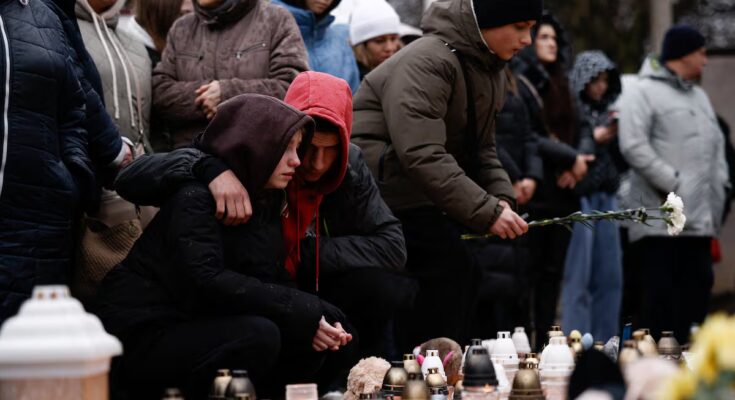The 28-point plan drawn up by Washington and Moscow to end the war was received in Ukraine like a splash of cold water. One reason for optimism in Kiev is that the document is being negotiated, President Volodymyr Zelensky said Thursday. The pessimism factor is that the draft would confirm that Donald Trump not only gives in to the interests of his Russian counterpart, Vladimir Putin, but also wants to take even more economic advantage from Ukraine’s weak position.
The leak of the agreement between Washington and Moscow sparked a storm in Kiev. The document was released exclusively by the American media Axios. The agreement was prepared between Steve Witkoff, Trump’s envoy for Russia and the Middle East, and Kirilo Dmitriev, Putin’s confidant. The text, according to the American press, was partially agreed with Rustem Umerov, one of the key people in Zelenskyj’s circle, current secretary of the National Security Council of Ukraine.
Umerov denied this Friday that he participated in or supported the document. His statements came after the newspapers The Wall Street Journal AND The New York Post published that it was Umerov who proposed one of the most controversial points: that both sides would accept an amnesty for all crimes committed during the war. The Russian army has killed more than 14,500 civilians in nearly four years of conflict.
Ukraine would then pledge not to seek justice for war crimes. In exchange, it would receive 100 billion dollars (86.8 billion euros) of Russian funds frozen abroad to rebuild the country. The United States would lead the management of these investments and the American companies involved would get 50% of the benefits, the document said.
Despite the severe defeat that these measures would mean for Ukraine, these would not be red lines. What would be unacceptable for Kiev are three of the clauses included in the text: the recognition of the provinces of Crimea, Donetsk and Lugansk as sovereign Russian territory (the latter two form the Donbas region); withdraw militarily from the 25% of the Donetsk region still under its control (this area would be demilitarized, but considered Russian sovereignty) and limit its armed forces to a troop of 600,000 soldiers. The Ukrainian army now has nearly one million soldiers, up from the 200,000 it had before the invasion began.
In the last few hours the Ukrainian president has maintained a cautious tone in his statements on the American proposal. “It must be a plan that guarantees a real and dignified peace,” Zelensky said this Friday after a telephone conversation with his French counterpart, Emmanuele Macron, the German Chancellor, Friedrich Merz, and the British Prime Minister, Keir Starmer. The Ukrainian leader also reported that they are working on the document prepared by Washington in coordination with allied countries.
Zelenskyj and his government had already reiterated to the White House that concessions are unacceptable. The last time was last October at the conference that Trump and Zelensky held with their teams in Washington. The clash between the Ukrainian leader and Witkoff was reported in the media when the latter reminded him that the Russian Constitution incorporated the provinces of Donbas, Zaporizhia and Kherson as part of the Russian Federation in 2022. “I asked Witkoff whether, in case Putin introduces another amendment to the Constitution of the Russian Federation after the end of the war, will we have to give up the territory again?” Zelenskyj explained this in a subsequent appearance to journalists. “And if, for example, I incorporate two regions of the Russian Federation into the Constitution of Ukraine, will these territories be given to us? It doesn’t work like that,” Zelensky said.
The 28-point plan not only recognizes Russia’s right of conquest, but also includes a clause warning that if Ukraine attempts to occupy Russian territory, it will lose American support. If Russia launches an invasion again, “in addition to (the United States) launching a coordinated and decisive military response, all global sanctions will be reinstated, recognition of the new territory, and all other benefits of this agreement will be revoked.”
The document, as published by Axios and other media, also specify that Ukraine will be punished if it launches missiles “on Moscow or St. Petersburg.” However, the text does not provide for Russia to be penalized if it launches missiles against Ukrainian cities.
Despite Dmitriev’s acknowledged involvement in the drafting, Dmitri Peskov, a Kremlin spokesman, said on Friday that the document was an American initiative and that Putin still had “no official document” on the table.
red lines
“The Ukrainian red lines are clear and we will not cross them,” Christina Gayovishin, Ukraine’s second permanent representative to the United Nations, said on November 20. The diplomat especially emphasized that it is impossible for Ukraine to renounce the sovereignty of its territory. “The territories temporarily occupied by Russia are not for sale,” he warned at a UN Security Council meeting dedicated to the November 19 Russian bombing, which left 31 dead in the city of Ternopil. Search operations for other victims continue.
Gayovishin also stated that his government will never sign any agreement that imposes restrictions on the development of its army. The diplomat was not only referring to the limit of soldiers that Ukraine can count on, but also to a point in the text which calls for its Constitution to introduce a chapter in which Ukraine expressly renounces being a future member of NATO.
The renunciation of sovereignty over part of the Ukrainian territory would also imply a constitutional reform that the government and the opposition consider almost impossible to achieve the two-thirds majority required in Parliament. Not only that, this reform should also receive the approval of the Supreme Court.
Ukraine’s position is the same as its European allies: before negotiating peace conditions, it is necessary to implement an unconditional ceasefire. The Kremlin rejects the latter option, arguing that a truce will only give Ukraine more time to rearm and that a temporary cessation of hostilities will not allow Russia to achieve its goals.
The ceasefire was indeed one of Ukraine’s essential demands, but the document drawn up between Witkoff and Dimitriev makes it clear that it will be the opposite: “Once all parties have accepted this memorandum, the ceasefire will begin immediately and both sides will withdraw to the agreed (frontline) lines.” This withdrawal would consist of the departure of Ukrainian soldiers from Donbas and maintaining the existing territorial division in the provinces of Zaporizhia and Kherson.
Russian troops began a new offensive in Zaporizhia this autumn, allowing them to advance at an unusually high pace. “Russian military advances should make it clear to Zelensky that it is better to reach an agreement now rather than later,” Peskov warned, “his options for making decisions independently are reduced to the speed with which Russian forces advance.”



